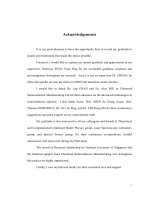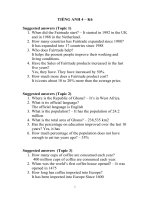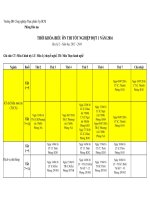Studies on genetic variability, heritability and genetic advance in fenugreek (Trigonella foenum-graecum L.) - Trường Đại học Công nghiệp Thực phẩm Tp. Hồ Chí Minh
Bạn đang xem bản rút gọn của tài liệu. Xem và tải ngay bản đầy đủ của tài liệu tại đây (247.61 KB, 7 trang )
<span class='text_page_counter'>(1)</span><div class='page_container' data-page=1>
<i><b>Int.J.Curr.Microbiol.App.Sci </b></i><b>(2017)</b><i><b> 6</b></i><b>(11): 4020-4036 </b>
4029
<b>Original Research Article </b>
<b>Studies on Genetic Variability, Heritability and Genetic Advance in </b>
<b>Fenugreek (</b>
<i><b>Trigonella foenum-graecum</b></i>
<b> L.) </b>
<b>Jyothi Veerayya Hosamath1*, R.V. Hegde1, C.K. Venugopal1, </b>
<b>A.G. Vijayakumar2 and M.G. Hegde3</b>
1
Department of Horticulture, College of Agriculture, University of Agricultural Sciences,
Dharwad - 580 005, Karnataka, India
2
Regional Agriculture Research Station, Vijayapur, Karnataka, India
3
Department of Agricultural Entomology, College of Agriculture, Dharwad, Karnataka, India
<i>*Corresponding author </i>
<i><b> </b></i> <i><b> </b></i><b>A B S T R A C T </b>
<i><b> </b></i>
<b>Introduction </b>
Fenugreek (<i>Trigonella foenum-graecum </i>L.) is
an important seed spice, belonging to the
family Fabaceae. It is a native of South
Eastern Europe and West Asia and is
extensively grown in India, Argentina,
Bulgaria, Egypt, France, Morocco, Spain,
Turkey, China, Pakistan and Lebanon. In
India, fenugreek is grown in about 93,090 ha
with an annual production of about 1,12,845
tonnes. Major producing states are Rajasthan,
Madhya Pradesh, Gujarat, Uttar Pradesh and
Tamil Nadu. During 2012-2013, India earned
about Rs. 10,488 lakhs foreign exchange by
exporting 29,622 tonnes of fenugreek (Anon.,
2014).
Fenugreek is self-pollinated crop with
chromosome number of 2n=16. Fenugreek is
<i>International Journal of Current Microbiology and Applied Sciences </i>
<i><b>ISSN: 2319-7706</b></i><b> Volume 6 Number 11 (2017) pp. 4020-4036 </b>
Journal homepage:
Thirty five germplasm of fenugreek (<i>Trigonella foenum-graecum </i>L.) along with check
were evaluated at University of Agricultural Sciences, Dharwad. High genotypic
coefficient of variability and phenotypic coefficient of variability coupled with high
heritability coupled with genetic advance as per cent mean were observed for the
characters plant height (30 and 60 DAS), number of branches per plant (60 and 90 DAS),
number of leaves (30, 60 and 90 DAS), number of pods per plant and hundred seed weight.
High heritability coupled with the high genetic advance as per cent mean were noted for
plant height (30 and 60 DAS), number of branches (60 and 90 DAS), number of leaves
(30, 60 and 90 DAS), leaf area, number of pods per plant and hundred seed weight. High
heritability with moderate genetic advance as per cent of mean was recorded for plant
height (90 DAS), days to 50 % flowering, days to maturity, pod length and pod width. The
characters like number of branches (30 DAS), chlorophyll content and number of seeds per
pod recorded moderate heritability coupled with low genetic advance over mean. The
studies indicates that the selection may be worthwhile in fenugreek for characters plant
height (30 and 60 DAS), number of branches per plant (60 and 90 DAS), number of leaves
(30, 60 and 90 DAS), number of pods per plant and hundred seed weight for achieving
higher yields.
<b>K e y w o r d s </b>
Fenugreek, Genetic
variability,
Heritability, Genetic
advance, <i>Trigonella </i>
<i>foenum-graecum.</i>
<i><b>Accepted: </b></i>
28 September 2017
<i><b>Available Online:</b></i>
10 November 2017
</div>
<span class='text_page_counter'>(2)</span><div class='page_container' data-page=2>
<i><b>Int.J.Curr.Microbiol.App.Sci </b></i><b>(2017)</b><i><b> 6</b></i><b>(11): 4020-4036 </b>
4030
a multipurpose crop being used as a spice,
leafy vegetables, fodder and as a medicinal
plant. The fresh tender leaves and shoots are
much used as a vegetable for human
consumption since ancient times and as
forage for cattle and also in medicine. The
seeds are used in colilc flatulence, dysentery,
diarrhoea, dyspepsia with loss of appetite,
chronic cough, dropsy and diabetes.
Fenugreek seeds are known to lower blood
glucose and blood cholesterol levels, because
they have large amounts of soluble fibre in
them. Fenugreek seeds contain substantial
amount of steroidal substance “diosgenin”
which is used as a starting material in the
synthesis of sex hormones and oral
contraceptives. It is also important for
animals, ground fine powder is mixed with
cotton seed and fed to cows to increase the
flow of milk.
Yield being a complex character, is
influenced by a number of yield contributing
characters controlled by polygenes and also
influenced by environment. So, the variability
in the collections for these characters is the
sum total of heredity effects of concerned
genes and the influence of the environment.
Hence, it becomes necessary to partition the
observed variability into heritable and
non-heritable components measured as genotypic
and phenotypic coefficients of variation
(GCV and PCV), heritability and genetic
advance expressed as per cent mean. Very
little information is available in this direction
on fenugreek. Keeping this in view, an
attempt was made in the present investigation
to assess the magnitude of variability,
heritability and genetic advance for different
characters in fenugreek germplasm.
<b>Materials and Methods </b>
The present investigation was undertaken
during<i> rabi </i> 2014-15 at Spice Unit, Main
Agricultural Research Station, University of
Agricultural Sciences, Dharwad. The
experimental material comprised of 35
diverse genotypes from different research
stations and local collections and the
genotype Gujarat Methi 2 was sown as check.
The experiment was laid out in Randomized
Complete Block Design with two replications.
The plot size was of 2 x 1 m with row to row
spacing of 30 cm and plant to plant spacing of
10 cm. All recommended agronomic practices
and plant protection measures were followed
timely for successful raising the crop. The
data on days to 50% flowering and days to
maturity was recorded on plot basis, while,
five plants were tagged at random to record
data on important growth and yield
contributing characters, which were analyzed
by the standard statistical methods.
Phenotypic and genotypic coefficients of
variation were estimated according to (Burton
and Devane, 1953). Heritability in broad
sense was estimated by (Hanson <i>et al., </i>1956).
The extent of genetic advance and genetic
advance as percentage over mean were
worked out using the formula suggested by
(Robinson, 1965).
<b>Results and Discussion </b>
The values of mean, range, phenotypic
coefficient of variation (PCV), genotypic
coefficient of variation (GCV), heritability,
genetic advance and genetic advance
expressed as per cent mean for all the
characters studied are presented in Table 1
and Figures 1 and 2.
</div>
<span class='text_page_counter'>(3)</span><div class='page_container' data-page=3>
<i><b>Int.J.Curr.Microbiol.App.Sci </b></i><b>(2017)</b><i><b> 6</b></i><b>(11): 4020-4036 </b>
4031
characters except leaf area under study
indicating the influence of G X E on most of
the characters. Higher values of phenotypic
and genotypic coefficient of variations were
observed for the characters like plant height at
30 DAS, number of branches (60 and 90
DAS), number of leaves at 90 DAS and
hundred seed weight. (Bhojanagouda, 2011;
Abhishek, 2012) for plant height; for number
of branches by (Datta <i>et al., </i>2005; Abhishek,
2012; Singh <i>et al.,</i> 2012; Prajapati <i>et al., </i>
2010), for 100 seed weight by (McCormick <i>et </i>
<i>al.,</i> 2009; Singh and Pramila, 2009;
Bhojanagouda, 2011). The result indicates
presence of very high degree of variability
and better scope for improvement.
Moderate GCV and high PCV were observed
for characters like plant height at 60 DAS,
number of leaves (30 and 60 DAS), number
of pods per plant and seed yield per plant. The
results indicate the existence of comparatively
high variability which could be exploited for
improvement through selection in advanced
generation. Similar observations were made
by (Sarada <i>et al.,</i> 2008; Bhojanagouda, 2011;
Abhishek, 2012; Singh <i>et al.,</i> 2012) for
number of pods per plant and seed yield per
plant.
Moderate PCV and GCV were observed for
the characters like plant height at 90 DAS,
number of branches (30 DAS), leaf area and
seed yield per hectare. These observations are
in confirmation with (Bhojanagouda, 2011)
for seed yield per plant. The characters <i>viz., </i>
chlorophyll content, days to 50% flowering,
days to maturity, pod length, pod width and
number of seeds per pod showed lower values
of PCV and GCV. Similar kind of results
were obtained by (Kailashchandra <i>et al., </i>
2000; Verma and Ali, 2012; Kumari <i>et al., </i>
2015) for days to 50% flowering; for days to
maturity by (Kumari <i>et al., </i>2015) and for pod
length by (Sarada <i>et al., </i>2008; Verma and Ali,
2012), for number of seeds per pod by
(Kailashchandra <i>et al., </i>2000; Kumari <i>et al., </i>
2015). This suggests presence of narrow
genetic base for these traits. Improvement in
these characters can be brought about by
hybridization or induced variability to widen
genetic base and then selecting in segregating
generations.
Low differences between PCV and GCV for
all traits except herbage yield per plant,
herbage yield per sq. m. and dry matter per
plant. Low differences between PCV and
GCV indicating that they are less affected by
environment and comparatively stable. Thus
phenotypic selection would be effective in the
improvement of these characters.
The characters <i>viz., </i>herbage yield per plant,
herbage yield per sq.m. and dry matter per
plant recorded moderate to high PCV and
GCV values with wide range, indicating more
influence of environment on these characters,
making them less amenable for improvement
through selection.
The estimates of heritability ranged from
21.59 per cent (number of branches at 30
DAS) to 97.70 per cent (Days to maturity).
The heritability was found to be higher for the
characters namely plant height (30, 60 and 90
DAS), number of branches (60 and 90 DAS),
number of leaves (30, 60 and 90 DAS), leaf
area, days to 50 % flowering, days to
maturity, number of pods per plant, pod
length, pod width and hundred seed weight.
Similar observations were made by (Sarada <i>et </i>
<i>al., </i> 2008; Bhojanagouda, 2011; Abhishek,
</div>
<span class='text_page_counter'>(4)</span><div class='page_container' data-page=4>
<i><b>Int.J.Curr.Microbiol.App.Sci </b></i><b>(2017)</b><i><b> 6</b></i><b>(11): 4020-4036 </b>
4032
<b>Table.1 </b>Variability, heritability and genetic advance in fenugreek genotypes
<b>Sl. </b>
<b>No. </b> <b>Characters </b> <b>Range </b> <b>Mean </b>
<b>GCV </b>
<b>(%) </b>
<b>PCV </b>
<b>(%) </b> <b>Heritability (%) </b>
<b>Genetic </b>
<b>advance </b>
<b>Genetic </b>
<b>advance </b>
<b>over mean </b>
<b>(%) </b>
1 Plant height at 30 DAS(cm) 1.80-22.90 16.43 22.78 23.99 90.16 7.32 44.56
2 Plant height at 60 DAS(cm) 24.40-76.30 57.12 19.16 20.02 91.61 21.58 37.79
3 Plant height at 90 DAS(cm) 45.20-88.60 71.73 9.84 12.28 64.17 11.68 16.24
4 Number of branches at 30 DAS 2.30-4.20 3.29 7.66 16.48 21.59 0.24 7.33
5 Number of branches at 60 DAS 4.80-14.70 9.13 25.34 28.28 80.27 4.27 46.76
6 Number of branches at 90 DAS 7.25-15.90 10.50 21.07 25.43 68.42 3.76 35.84
7 Number of leaves at 30 DAS 12.60-24.50 18.81 17.45 20.23 74.41 5.90 31.01
8 Number of leaves at 60 DAS 53.30-104.90 76.50 15.77 20.36 60.01 19.26 25.17
9 Number of leaves at 90 DAS 23.95-94.33 38.43 32.48 34.07 90.88 24.12 63.79
10 Leaf area (cm2) 5.23-9.24 7.38 12.70 12.94 87.00 1.71 23.20
11 Chlorophyll content (SPAD
units) 46.75-60.91 55.14 3.45 6.29 30.04 2.15 3.89
12 Herbage yield per plant (g) 9.57-21.83 16.67 11.30 20.36 30.80 2.15 12.92
13 Herbage yield per sq.m. (kg) 0.33-0.76 0.58 11.87 22.15 28.72 0.08 13.10
14 Dry matter content(g/plant) 1.23-5.16 3.30 17.77 31.27 32.32 0.69 20.81
15 Days to 50% flowering 35.50-56.00 42.01 8.45 9.31 82.38 6.64 15.80
16 Days to maturity 76.50-109.00 85.33 7.43 7.34 97.70 12.76 14.95
17 Number of pods per plant 21.40-55.30 39.38 17.46 23.48 55.27 10.53 26.74
18 Pod length (cm) 8.03-11.48 10.29 6.49 7.94 66.73 1.12 10.92
19 Pod width (mm) 3.18-4.06 3.59 5.48 6.06 81.54 0.37 10.19
20 Number of seeds per pod 12.48-16.18 14.50 4.03 6.44 39.19 0.75 5.20
21 Hundred seed weight (g) 1.03-2.55 1.70 20.60 28.12 53.65 0.53 31.08
22 Yield per plant (g) 3.35-9.65 6.78 17.46 24.85 49.39 1.70 25.28
</div>
<span class='text_page_counter'>(5)</span><div class='page_container' data-page=5>
<i><b>Int.J.Curr.Microbiol.App.Sci </b></i><b>(2017)</b><i><b> 6</b></i><b>(11): 4020-4036 </b>
</div>
<span class='text_page_counter'>(6)</span><div class='page_container' data-page=6>
<i><b>Int.J.Curr.Microbiol.App.Sci </b></i><b>(2017)</b><i><b> 6</b></i><b>(11): 4020-4036 </b>
</div>
<span class='text_page_counter'>(7)</span><div class='page_container' data-page=7>
<i><b>Int.J.Curr.Microbiol.App.Sci </b></i><b>(2017)</b><i><b> 6</b></i><b>(11): 4020-4036 </b>
4035
Heritability estimates in broad sense when
used in conjunction with the genetic advance
would give better information than the
heritability alone. In the present study, high
heritability coupled with the high genetic
advance as per cent mean were noted for plant
height (30 and 60 DAS), number of branches
(60 and 90 DAS), number of leaves (30, 60
and 90 DAS), leaf area, number of pods per
plant and hundred seed weight suggesting the
role of additive gene action in the expression
of these characters and as such could be
considered as the reliable indices for
improvement through selection. These
findings are also supported by the results of
(Sarada <i>et al., </i> 2008; Bhojanagouda, 2011;
Abhishek 2012) for plant height; for number
of branches by (Datta <i>et al., </i>2005; Prajapati <i>et </i>
<i>al., </i>2010; Abhishek 2012; Jain <i>et al.,</i> 2013),
for number of pods per plant by (Prajapati <i>et </i>
<i>al., </i>2010; Abhishek 2012; Verma and Ali,
2012; Kumari <i>et al., </i>2015) for hundred seed
weight by (Bhojanagouda, 2011; Verma and
Ali, 2012; Jain <i>et al.,</i> 2013). High heritability
with moderate genetic advance as per cent of
mean was recorded for plant height (90 DAS),
days to 50 % flowering, days to maturity, pod
length and pod width. Similar results were
obtained by (Balai <i>et al., </i>2006; Prajapati <i>et </i>
<i>al., </i> 2010) for plant height; for days to
maturity by (Prajapati <i>et al., </i> 2010). The
results indicate that these characters were less
influenced by environment but governed by
additive and non-additive gene action.
The characters like number of branches (30
DAS), chlorophyll content and number of
seeds per pod recorded moderate heritability
coupled with low genetic advance over mean.
This was the indicative of dominant and
epistatic effects for these characters.
Thus, there is influence of environment for
these characters. Similar reports were also
given by (Balai <i>et al., </i>2006; Jain <i>et al.,</i> 2013)
for number of seeds per pod.
From present investigation, high genotypic
coefficient of variability and phenotypic
coefficient of variability coupled with high
heritability coupled with genetic advance as
per cent mean were observed for the
characters plant height (30 and 60 DAS),
number of branches per plant (60 and 90
DAS), number of leaves (30, 60 and 90 DAS),
number of pods per plant and hundred seed
weight. This indicates that there is a lesser
influence of environment in the expression of
characters which are amenable for selection.
<b>References </b>
Abhishek, N., 2012. Characterization of
fenugreek (<i>Trigonella foenum-graecum </i>
L<i>.) </i> genotypes through morphological
characters<i>. Int. J. Agric. Env. Biotech.,</i>
5(4): 453-457.
Ahari, S. D., Hassandokht, M. R., Kashi, A.
K., Amri, A. and Alizadeh, K. H., 2010.
Genetic variability of some agronomic
traits in the Iranian fenugreek landraces
under drought stress and non-stress
conditions. <i>Afr. J. Plant Sci., </i>4(2):
12-20.
Anonymous, 2014. <i>Indian </i> <i>Horticulture </i>
<i>Database</i>. <i>www.nhb.gov.in</i>
Balai, O. P., Singh, D. and Jain, U. K., 2006.
Genetic variation and character
association among yield and yield
related traits in fenugreek. <i>Indian J. </i>
<i>Agric. Res., </i>40(2): 143-146.
Bhojanagouda, P., 2011. Evaluation of
fenugreek genotypes under northern
transitional belt of Karnataka. <i>M. Sc. </i>
<i>(Agri.) Thesis</i>, Univ. Agric. Sci.,
Dharwad, Karnataka (India).
Burton, C. W. and Devane, R. W., 1953.
Estimating heritability in tall fescue
from replicated clonal material. <i>Agron. </i>
<i>J., </i>4: 78-81.
</div>
<!--links-->
Ôn tập triết học cao học trường đại học nông nghiệp hà nội
- 42
- 387
- 0








